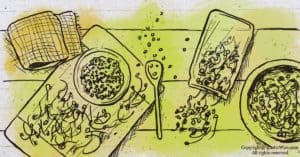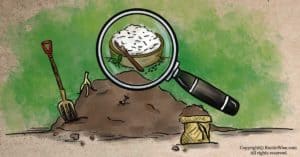How To Grow Clover Sprouts: A Mild and Wholesome Green
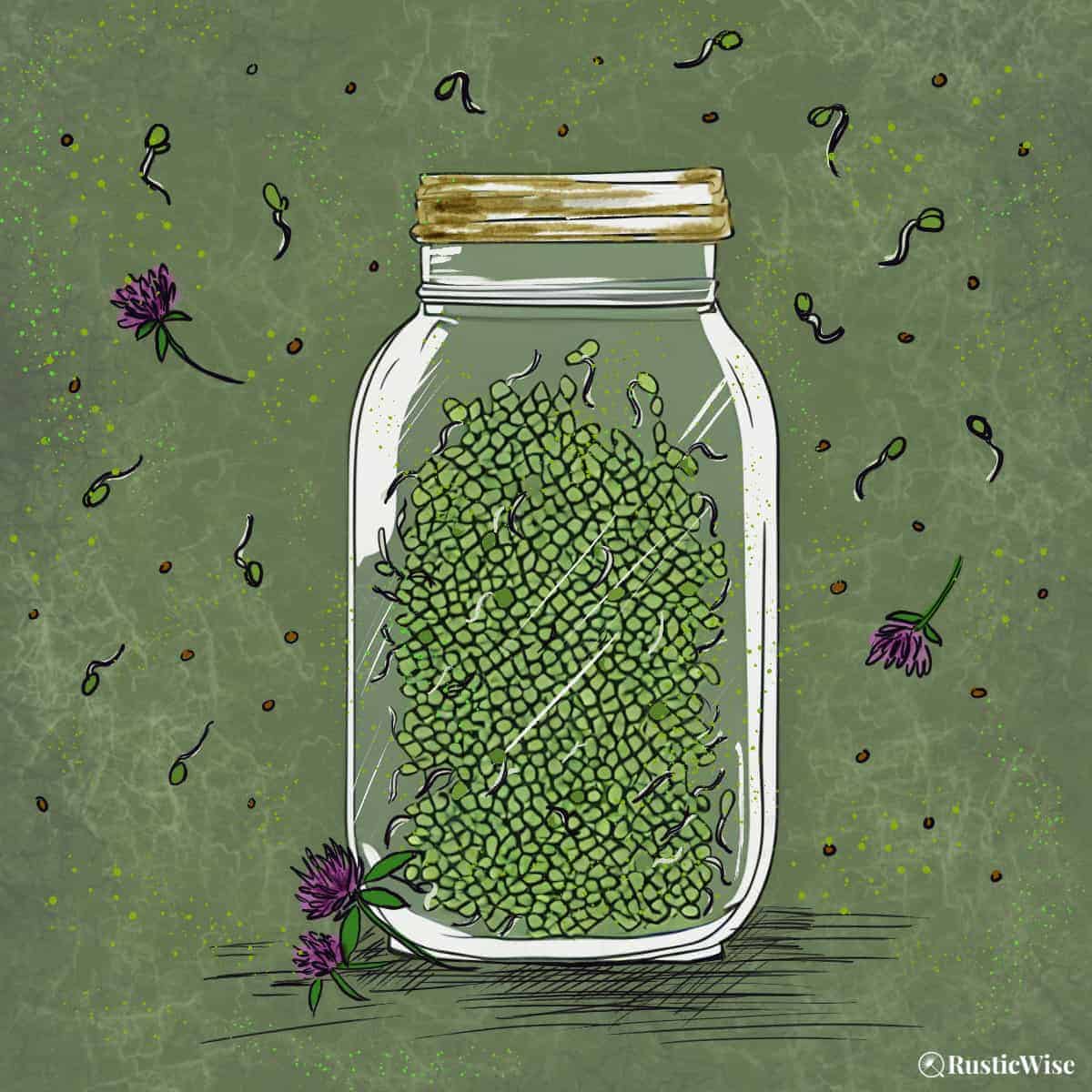
Move over alfalfa. There’s another healthy green that’s also mild tasting and versatile to add to your salad mix: clover. Clover sprouts are easier to grow at home than alfalfa as they shed their hulls more readily.
Red clover in particular is packed with nutrients and health benefits. It’s a great source of complete protein, contains vitamins C and K, and contains plenty of isoflavones, plant-based estrogen-like compounds.
You can grow clover sprouts on your countertop easily with a glass jar, a sprouting lid (or piece of cheesecloth and elastic band), and some good sprouting seeds. Let’s take a look at some of the health benefits of red clover, as well as how to sprout your own red clover seeds, step by step.
A closer look at the red clover plant
If you come to a meadow, chances are you’ll find a patch of clover. It belongs to the pea/legume family (Fabaceae). The clover plant can be found growing wild in most temperate regions around the globe.¹
This flowering herb provides a wonderful source of food for pollinators, and livestock love snacking on this protein and calcium-rich forage crop. This explains the other names this flowering plant goes by: beebread, cow clover, cow grass, and meadow clover, to name a few.
Beyond its benefits to wildlife, it’s also a nutritious green for humans too! In particular, red clover (Trifolium pratense), characterized by its light purple flowers, is one of the most commonly used and widely spread species.
Did you know that the red clover is a popular herbal remedy used around the world? According to the Icahn School of Medicine at Mount Sinai, Trifolium pratense has been used traditionally to treat a wide range of ailments such as cancer, skin inflammation issues (such as eczema), and whooping cough. It’s also said to have detoxifying properties that can help cleanse the blood and liver.²
Types of clover plants
There are roughly 300 different types of clover plants in the genus Trifolium.¹ Some are annual, others are perennial, and some are winter annuals.
The main type that people use for sprouting is red clover (Trifolium pratense).
There are also other varieties that are not commonly used for sprouting, including:³
- Alsike clover (Trifolium hybridum)
- Arrowleaf Clover (Trifolium vesiculosum Savi)
- Crimson Clover (Trifolium incarnatum)
- Strawberry Clover (Trifolium fragiferum L.)
- White Clover (Trifolium repens)
What exactly are clover sprouts?
Sprouts are simply raw clover seeds that have been soaked in water and kept in controlled moist conditions to stimulate growth. The tiny roots and shoots that emerge from the seeds are what we call sprouts.
Sprouting is a quick and easy process that requires little space (perfect for urban gardeners). Fresh clover greens can be ready to eat between 4 and 6 days.
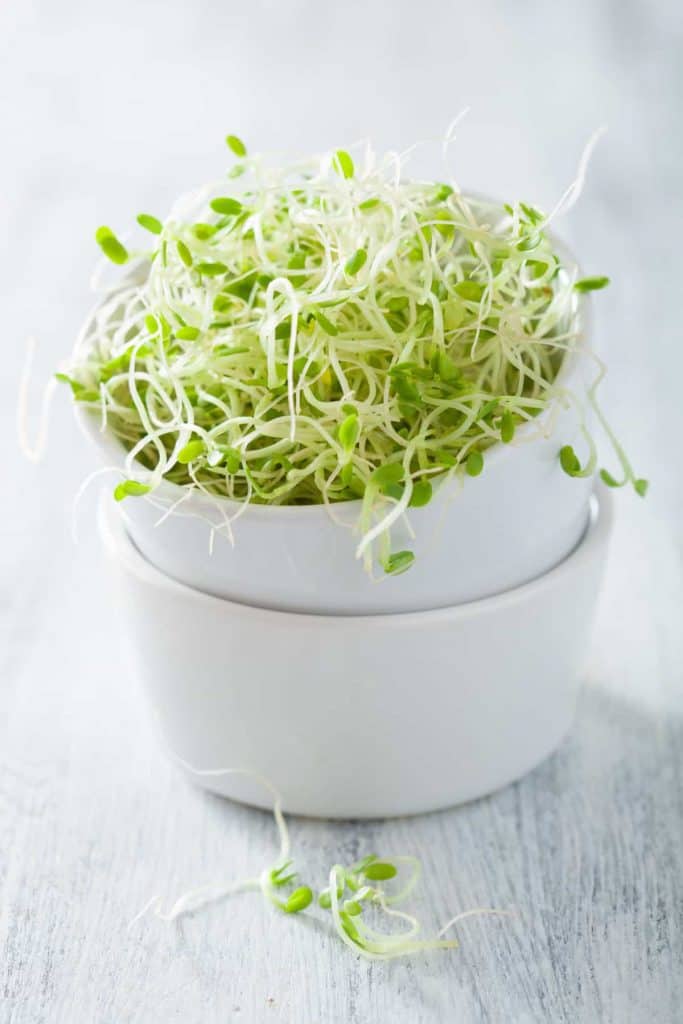
Credit: Vector State
What’s so great about sprouts, anyway?
While we know the importance of eating fresh veggies as part of a balanced diet, the sprouting process increases nutrient availability that’s normally not available in other forms.
During the sprouting process, seeds are first soaked to coax them from dormancy. Next, seeds are regularly rinsed and drained to encourage germination. The tiny roots or shoots that emerge are packed with nutrients.
In their raw, unsprouted form, most seeds contain antinutrients including phytic acid. Antinutrients inhibit the absorption of nutrients by the body. Sprouted seeds however neutralize or lower phytic acid levels, which allow your body to access greater levels of vitamins and minerals.
Sprouted seeds also boost the amount of insoluble fibers (which helps with digestion), and other hard-to-digest starches into simpler forms. All this leads to easier digestion.
Plus, sprouts are just fun and tasty greens that enhance the texture and flavor of salads, sandwiches, wraps, soups, and stews.
Nutrition benefits of sprouted clover
When it comes to types of clover health and nutrition, the red variety comes out on top. Include this sprout as an integral part of a healthy plant-rich diet.
- Packed with protein: Red clover offers a complete source of plant-based protein. (Other sprouts that also offer complete proteins include alfalfa, mung bean, broccoli, chickpea, lentil, quinoa, and soybean sprouts.)⁴
- Wholesome: These tiny shoots are packed with goodness. Red clover contains ample amounts of calcium, chromium, dietary fiber, iron, vitamins C and K, folate, magnesium, niacin, phosphorus, potassium, and thiamine.² ⁴
- May help prevent cancer: Red clover contains genistein, a compound that fights cancer by blocking the formation of new blood vessels in tumors. This helps prevent the spread of cancer.⁴
- Rich in isoflavones: Isoflavones (a phytoestrogen) found in clover may help ease symptoms of menopausal symptoms such as hot flashes, and PMS.⁴
- May protect against heart disease: Some studies show that this plant helps raise HDL (“good”) cholesterol levels, which helps maintain heart health.²
The takeaway: While there are many studies that show the positive effects of isoflavone, there are also conflicting studies as to exactly how effective red clover may be at cancer-prevention, and easing menopausal symptoms.² Talk to your doctor to see if red clover is right for you.
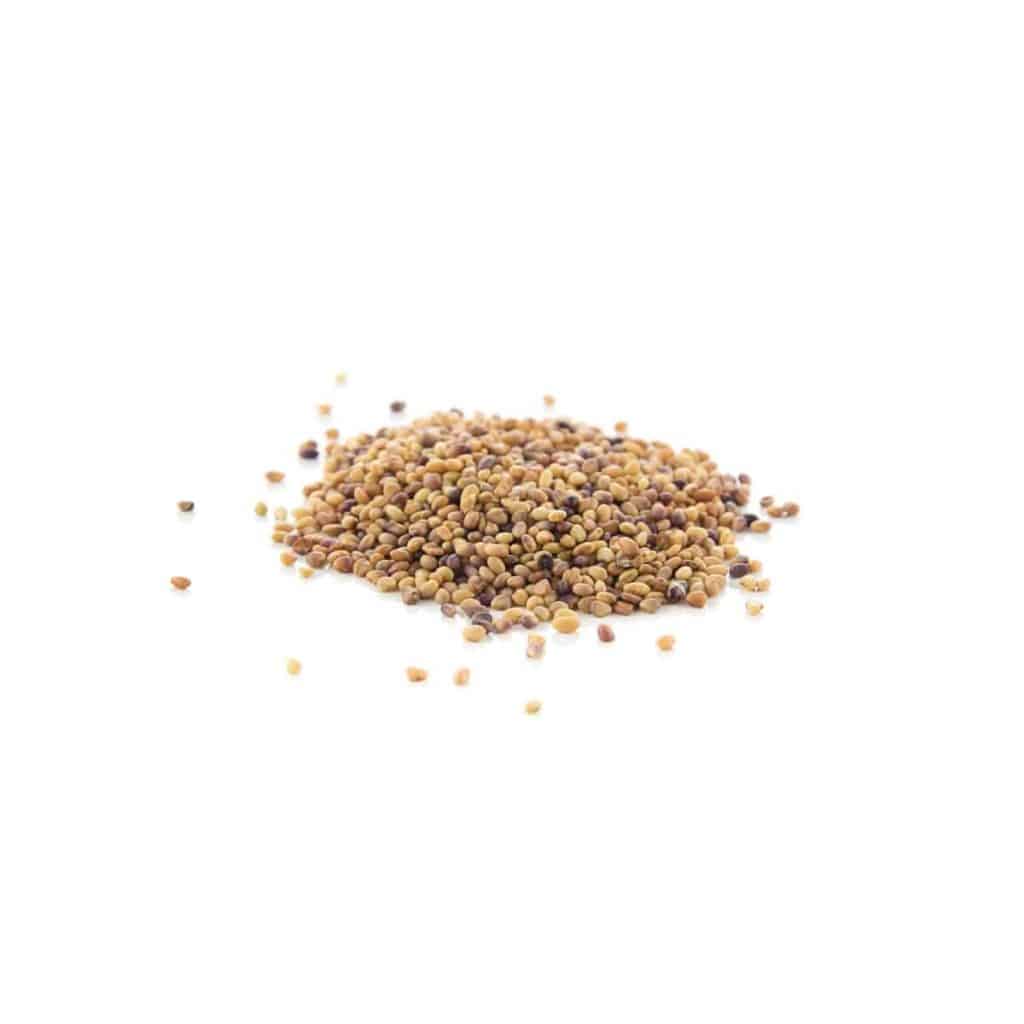
Credit: Deposit Photos
How to grow clover sprouts in a jar
Covering the spectrum of health benefits, these nutrient-packed sprouts are great to eat and easy to grow. The great thing about this sprout is that it has a very high yield. You can get more bang-for-your-buck!
If you’re just starting out with sprouting at home, I highly recommend you check out our essential guide to sprouting to get you all caught up with the basics.
Growing notes: Roughly 1 tablespoon of seeds produces between 1½ to 2 cups of sprouts. You can harvest anytime between 4 and 6 days. Red clover produces tiny green and white sprouts. Don’t expect your sprouts to be red-colored!
Supplies
All you need to get started are some quality seeds, a bit of patience, and some very basic equipment. You can easily find quality organic red clover seeds at most seed suppliers—these greens are one of the most popular varieties, for good reason!
- 1-quart glass mason jar
- Sprouting lid or piece of cheesecloth/muslin and rubber band
- 1 to 2 tablespoons of quality organic clover seeds
- Clean water (filtered)
- Colander
Grow clover sprouts step by step
Follow these simple steps and your sprouts will be ready to harvest in 4–6 days!
- Measure seeds: Portion out roughly 1 to 2 tablespoons of seeds per quart jar.
- Inspect and wash seeds: Do a quick inspection and toss out any damaged seeds and other debris. Place the seeds in the jar, swirl, and rinse with clean cool water. Drain.
- Soak: Fill the jar with clean water again and ensure the seeds are fully submerged under water. You may need to swirl them and push them underneath the waterline. Let them soak overnight, or for 4 to 12 hours. This soaking period helps to coax the seeds from dormancy. Place sprouting lid or fasten cheesecloth onto the jar with an elastic band.
- Drain: After the seeds have soaked, drain the excess water by tipping the jar upside down. You could also rest it at an angle inside a bowl for more thorough draining.
- Rinse and drain the seeds: After the initial soak, continue to rinse with cool water at least twice a day, or every 8–12 hours. Don’t skimp on this step! Improper drainage often leads to moldy sprouts. Keep the jar out of direct sunlight at room temperature. It does not need to be in a completely dark location—a shady corner of the kitchen will do.
- Harvest: It’s best to harvest to taste, so try tasting a few sprouts each time your rinse/drain. Most clover sprouts are ready to harvest between Days 4–6. When harvesting, give your sprouts one last rinse under cold water in a colander to remove any seed hulls or other residue. If you find you have a lot of seed hulls remaining, you can place the sprouts in a bowl of cool water. The hulls will float to the surface. Allow to drain fully in a colander for several hours, and pat dry. Keep in the refrigerator.
How long do clover sprouts last?
Once your sprouts dry, you can store them in the refrigerator. (Any moisture on sprouts causes them to spoil more quickly.)
Sprouts are best consumed within 2 to 3 days. But clover sprouts may last up to a week. They tend to last longer than alfalfa sprouts, too. Store in the fridge up to a week in a sealed glass container, plastic bag, or Tupperware. Check out our article on tips for keeping bean sprouts fresh for longer.
I find that storing my sprouts in a reused yogurt container with a few holes drilled in helps to keep them fresh for longer. The key is finding the sweet spot between giving them a bit of air, but not so much that they dry out.
Can you grow clover microgreens?
Yes, absolutely. Unlike sprouts, microgreens are grown in soil or another type of growing medium. You harvest micros just above the soilline, whereas you eat sprouts in their entirety: seed, root, and shoot. Growing microgreens takes a bit longer than sprouting—most clover microgreens are ready to harvest in less than 12 days.
What do red clover sprouts taste like (plus how to use them)
Similar to alfalfa, clover has a very mild and versatile flavor that blends well with pretty much any dish. It has a very delicate, nutty-sweet taste with a slightly crunchy texture.
While many people enjoy them raw, some people may prefer to cook them.
Note: Some vulnerable populations should avoid eating raw sprouts as a safety precaution. This includes pregnant or breastfeeding women, those with underlying health conditions, or the very young or elderly.
- Add to smoothies: The very agreeable flavor of Trifolium pratense makes it easy to blend into healthy smoothies or juices. Try blending with a handful of baby spinach or kale, apples, oranges, or frozen fruits.
- Make a dip: Whether you like spicy or savory dips, red clover makes a healthy addition to homemade dips along with your favorite spices and seasonings.
- Make it a salad green: This sprout’s flavor is something you won’t get tired of. Try creating a blend of greens with spicier sprout varieties such as radish or mustard.
- Use like other leafy greens: Add to sandwiches, wraps, or use as a topping to garnish pizza.
- Add to cooked dishes: Add these tiny and tender sprouts during the last few minutes of cooking to soups and stews.
👉If you like this post, see our Essential Sprouting Guide: How To Grow Sprouts at Home.
Would you like more timeless tips via email?
Fun tips to help you live an independent, self-sustaining lifestyle. Opt-out at any time.


References
- Britannica, Clover plant, https://www.britannica.com/plant/clover-plant. Accessed October 2022.
- Icahn School of Medicine at Mount Sinai, Red clover, https://www.mountsinai.org/health-library/herb/red-clover. Accessed October 2022.
- Oregon State University, Clover species, https://forages.oregonstate.edu/matchclover/species. Accessed October 2022.
- Evans, Doug (2020). The Sprout Book: Tap into the Power of the Planet’s Most Nutritious Food. St. Martin’s Publishing Group. ebook.

Author: Josh Tesolin
Josh is co-founder of RusticWise. When he’s not tinkering in the garden, or fixing something around the house, you can find him working on a vast array of random side projects.


